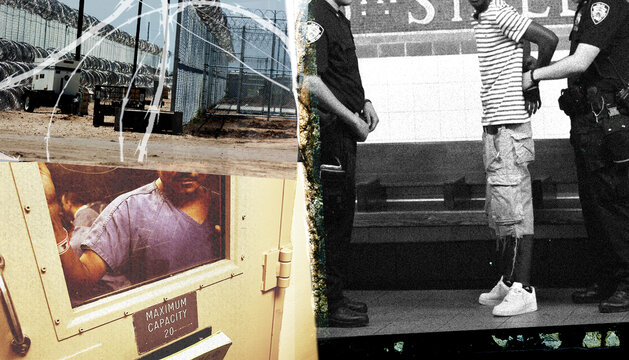
The American ‘Punisher’s Brain’
U.S. sentencing practices seem especially extreme when compared with countries like Canada, Germany, and the Netherlands.

Part of
This essay is part of the Brennan Center’s series examining the punitive excess that has come to define America’s criminal legal system.
Our penchant for punitive sentencing goes back beyond the Constitution or the Pilgrims or even British common law. It goes back further than the Magna Carta or the Code of Hammurabi or the Talmud, back to the dawn of human history, when small groups of people adopted concepts of culpability and punishment as a matter of basic survival. Our ancient ancestors shamed and weeded out the rule-breakers among them, sometimes with leniency, usually in harsh ways, to protect the integrity and the unity of their tribe.
All humans may be hardwired to be cruel in a fashion. But as Robert Ferguson argued in his 2014 masterwork, Inferno, the United States has allowed these instincts to dominate criminal justice policy. The result over the past half century has been an unprecedented era of mass incarceration. On any given day, more than 2 million people are locked up in the nation’s 5,000 or so prisons and jails, many serving sentences grossly disproportionate to the nature of their crimes. And that doesn’t even include another 50,000 or so people effectively imprisoned in federal or private immigration detention centers.
A 2016 report by the Brennan Center for Justice concluded that nearly 40 percent of the prison population at the time — nearly 600,000 people, or more than the entire population of Atlanta or Milwaukee — was imprisoned without any legitimate public safety justification. Moreover, as the Sentencing Project recently revealed, there are more people serving life sentences today across the nation — some 206,000 people in federal and state prisons — than there were people in prison altogether in the United States in 1970. In fact, 83 percent of the world’s population of life-without-parole prisoners is living behind American bars.
But if retributive justice is in our DNA, if punishment comes down to us from prehistory, why is American justice so much harsher than it is in other Western democracies? The Netherlands, for example, imprisons its citizens at a per capita rate that is one-tenth the American per capita rate for all sorts of criminal offenses.
One obvious root of this exceptionalism is America’s endless struggle over racial justice. We endured punitive sentencing in the racist “Black Codes” that sprung up in southern states after the Civil War to incarcerate or force newly freed slaves into a form of indentured servitude. We saw it in “convict leasing.” We saw the same in the formation of Jim Crow laws sanctioned by the Supreme Court and in the discriminatory housing and employment practices and policies the law allowed.
Modern punitive sentencing schemes began to take root half a century ago, when the Nixon administration began its “war on drugs,” a futile battle the nation is still waging. These punitive efforts metastasized in the late 1980s and early 1990s, when a nationwide crime wave generated a “tough on crime” response that led to the creation and enforcement of “three-strikes” laws, expanded the scope of mandatory minimum sentences, and fueled “truth in sentencing” measures. All of these, together, vastly expanded the number of people sent to federal and state prisons.
Those policies are largely still with us, three decades later, despite recent reforms and a decades-long decline in violent crime. So, in some jurisdictions, is capital punishment. At the same time, there has been an explosion of excessively punitive sex offender laws, requiring registration on lists, imposing residency restrictions, and even imprisoning people for “treatment” long after their prison terms have been completed.
Roughly 20 such “civil commitment programs” now exist in various states, and many of the people in them may be indefinitely detained. We also see the American “punisher’s brain,” as Colorado Judge Morris Hoffman once put it, in the often inhumane ways in which the condemned are forced to serve out these sentences in dangerous, dirty prisons bereft of adequate health care. And we see it all even though there still appears to be little compelling evidence justifying excessively punitive sentences. In fact, a growing body of evidence has undermined long-perceived links between public safety and the length of prison sentences.
The rise of habitual offender three-strikes laws is a good example of the excessively punitive dynamic. These sentencing laws, a byproduct of the 1990s “law and order” push, generally require judges to mete out life-without-parole sentences to defendants who commit at least three offenses if the most recent of them is considered a “serious” felony. Judges and legislators in some states have used particularly broad definitions of these triggering offenses. In Washington, for example — the first state to enact a three-strikes law — second degree robbery was for decades a three-strike-triggering offense even though it was statutorily defined as a crime without a weapon and without injury to the victim.
“Truth in sentencing” state laws, also spawned during the 1980s and early 1990s, are another good example of the ways in which American policymakers have imposed particularly harsh sentencing regimes. These laws were enacted to require prisoners to serve a higher proportion of their sentences than had been the practice, with much less “time off” for “good behavior” and much less deference given to the judgments of local parole boards. Once again, Washington was the first state to enact such a measure, in 1984, and today at least 40 states and the District of Columbia have some form of it on the books.
Mandatory minimum sentences are similarly widespread. The last 75 years or so have seen the tide of federal mandatory minimums ebb and flow. From the 1950s to 1970s it expanded. Then it receded. The Comprehensive Drug Abuse Prevention and Control Act of 1970, a progressive law from the Nixon era, abolished mandatory minimum sentences for almost all drug offenses. Then the politics of crime and justice turned again toward harsher punishment and more incarceration, and from the mid 1980s until just a few years ago Congress churned out one new mandatory minimum sentencing scheme after another, even after doubts were raised about their effectiveness.
The harshness of these sentencing regimes is magnified when they are compared to those in other countries. For example, American laws have long granted trial judges the freedom to impose consecutive sentences on separate charges related to the same crime — in many instances effectively lengthening a defendant’s sentence to life without parole, but without saying so. There are U.S. prisoners sitting in their cells with 200-year sentences. By contrast, only within the last decade were Canadian trial judges even allowed to issue consecutive sentences, and only in murder cases, specifically to ensure longer sentences before parole eligibility. European countries are even more enlightened in their sentencing approaches.
Disparities in sentencing are especially stark when compared to practices in such European countries as Germany and the Netherlands. The laws and criminal justice policies of these nations don’t just differ from their American counterparts in the details — they differ in philosophy. The U.S. “punisher’s brain” is absent from European justice models, which emphasize rehabilitation and resocialization. Germany’s Prison Act, for example, specifically states that the very purpose of incarceration is to help prisoners lead lives of “social responsibility free of crime” upon release.
The vast majority of defendants convicted of crimes in Germany and the Netherlands — even what we would consider “crimes of violence” in the United States — never spend any measurable time in prison. Most are diverted into other programs, or forced to pay fines, or given suspended sentences. These practices, and the emphasis on rehabilitation for those prisoners who are kept behind bars, go hand-in-hand with low crime and recidivism rates in those countries.
When it comes to punitive sentencing regimes, Canada sits somewhere in between the American and European models. Only 29 crimes in Canada’s criminal code carry a mandatory minimum sentence, most having to do with firearm-related offenses in a nation that has no Second Amendment. Canada did enact its own “truth in sentencing” law in 2009 — federal legislators wanted to be more punitive — but the measure was struck down five years later by a unanimous Supreme Court of Canada.
American sentencing laws are still harsher than those of counterparts in many other democracies, and we are still by far the world’s incarceration leader, but recent bipartisan justice reforms on both a federal and state level have begun to change the American punishment narrative. Citing evidence-based practices and relying on statistics undermining long-held justifications for many punitive sanctions, justice reformers across the country have convinced policymakers that the costs of excessive sentences don’t just fall on the incarcerated or their families but rather on all of us.
More from the Punitive Excess series
-
Treating All Kids as Kids
Persistent and longstanding racism has fueled harsher treatment of young Black people in the justice system. -
What Did You Call Me?
An incarcerated person writes about how dehumanizing language like “inmate” is destructive. -
The Federal Funding that Fuels Mass Incarceration
Decades of financial incentives by the federal government have encouraged states and cities to put more people behind bars for longer, with devastating results.



